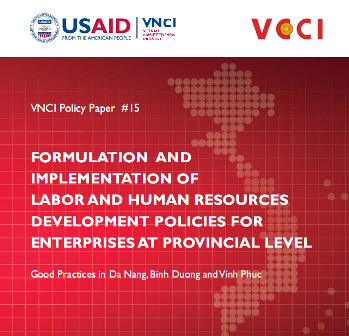
 The study is the forthcoming 15th VNCI - VNCI Policy Paper |
According to aggregate statistics from job service centers across Vietnam, there were 100,000 jobs being offered in 2009. However, the number of persons who sought jobs from the centres accounted for only 17% of the total demand from the enterprises. More worryingly, only 6% of the job seekers could meet the qualifications and criteria set by recruiters. The main reason resulting in the mismatch between the offer and demand of labor is the fact that training failing to meet the market demands. Only 26% of the labor force are trained on basic skills. Of which, those who are trained at vocational colleges account for merely 6.47%. |
| Despite this fact, universities and colleges mostly expand the training and education which require less capital investment like economics, law, business administration… and pay much less attention to more capital or technology intensive training. For example of the 30,000 university graduates, 30% are majored in economics, 21% in social science and 46% of all the others. Under the Provincial Competitiveness Index (PCI), labor training is the sub-index to which the highest weight is attributed. However, it is also one of the sub-indices that scored the lowest and experienced the sharpest decline in 2008. Labor policy has always been one of the three most challenging dimensions. The latest survey results (in 2008) reveal that in a median province, as low as 19.81% of enterprises rated the quality of vocational training provided by local government agencies as good and very good. In such a context, the Vietnam Competitiveness Initiative (VNCI) conducted this study to acquire a deeper insight into best practices and policies adopted by provinces in the field labor and human resources development. Economica was commissioned by the Initiative to carry out the study. The provinces selected for the purpose of the study were Da Nang, Vinh Phuc and Binh Duong. The study is expected to provide additional food for thoughts in the formulation and implementation of labor and human resource development policies by different provinces. The study is planned to be made available to the public soon. |
|
 Study on the Quality of Private Enterprises in Vietnam (14/01/2010)
Study on the Quality of Private Enterprises in Vietnam (14/01/2010)
 Regulatory Impact Assessment (RIA) of the Mineral Law (01/02/2010)
Regulatory Impact Assessment (RIA) of the Mineral Law (01/02/2010)
 Training Need Assessment of Vietnamese Business Associations (10/02/2010)
Training Need Assessment of Vietnamese Business Associations (10/02/2010)
 Economica's Study Caught in Headlines of National Newspapers (03/03/2010)
Economica's Study Caught in Headlines of National Newspapers (03/03/2010)
 Training courses on policy advocacy for business associations delivered (15/05/2010)
Training courses on policy advocacy for business associations delivered (15/05/2010)
 Strategy Development for MITRACO & Coporate Restructuring for DFC (27/06/2010)
Strategy Development for MITRACO & Coporate Restructuring for DFC (27/06/2010)
 Contribution to APEC HRD Expert Meeting (08/05/2012)
Contribution to APEC HRD Expert Meeting (08/05/2012)
 Improving Provincial Competiveness Index and Business Environment (08/05/2012)
Improving Provincial Competiveness Index and Business Environment (08/05/2012)
 Local Economic Development to Improve National Competitiveness (08/05/2012)
Local Economic Development to Improve National Competitiveness (08/05/2012)
 Moving from necessity-driven entrepreneurial activity to development of high performance SMEs (08/05/2012)
Moving from necessity-driven entrepreneurial activity to development of high performance SMEs (08/05/2012)